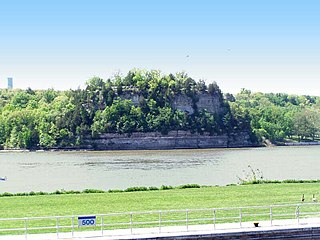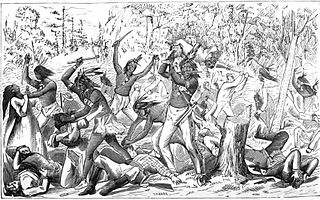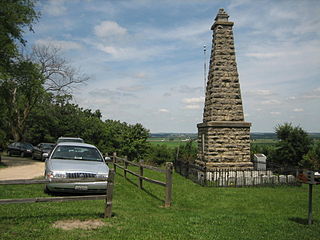
The Quad Cities is a region of cities in the U.S. states of Iowa and Illinois: Davenport and Bettendorf in southeastern Iowa, and Rock Island, Moline and East Moline in northwestern Illinois. These cities are the center of the Quad Cities metropolitan area, a region within the Mississippi River Valley, which as of 2023 had a population estimate of 467,817 and a Combined Statistical Area (CSA) population of 474,019, making it the 90th-largest CSA in the nation.

The Sauk or Sac are Native Americans and Indigenous peoples of the Northeastern Woodlands. Their historical territory was near Green Bay, Wisconsin. Today they have three tribes based in Iowa, Kansas, Nebraska, and Oklahoma. Their federally recognized tribes are:

The Black Hawk War was a conflict between the United States and Native Americans led by Black Hawk, a Sauk leader. The war erupted after Black Hawk and a group of Sauks, Meskwakis (Fox), and Kickapoos, known as the "British Band", crossed the Mississippi River, to the U.S. state of Illinois, from Iowa Indian Territory in April 1832. Black Hawk's motives were ambiguous, but he was apparently hoping to reclaim land that was taken over by the United States in the disputed 1804 Treaty of St. Louis.

Starved Rock State Park is a state park in the U.S. state of Illinois, characterized by the many canyons within its 2,630 acres (1,064 ha). Located just southeast of the village of Utica, in Deer Park Township, LaSalle County, Illinois, along the south bank of the Illinois River, the park hosts over two million visitors annually, the most for any Illinois state park.

Keokuk was a leader of the Sauk tribe in central North America, and for decades was one of the most recognized Native American leaders and noted for his accommodation with the U.S. government. Keokuk moved his tribe several times and always acted as an ardent friend of the Americans. His policies were contrary to fellow Sauk leader Black Hawk, who led part of their band to defeat in the Black Hawk War, was later returned by U.S. forces to Keokuk's custody, and who died a decade before Keokuk.

The Rock Island Arsenal comprises 946 acres and is located on Arsenal Island, originally known as Rock Island, on the Mississippi River between the cities of Davenport, Iowa, and Rock Island, Illinois. It is home to the United States Army First Army Headquarters, and the United States Army Center of Excellence for Additive Manufacturing.

Black Hawk, born Ma-ka-tai-me-she-kia-kiak, was a Sauk leader and warrior who lived in what is now the Midwestern United States. Although he had inherited an important historic sacred bundle from his father, he was not a hereditary civil chief. Black Hawk earned his status as a war chief or captain by his actions: leading raiding and war parties as a young man and then a band of Sauk warriors during the Black Hawk War of 1832.

The Bad Axe Massacre was a massacre of Sauk (Sac) and Meskwaki (Fox) Native Americans by United States Army regulars and militia that occurred on August 1–2, 1832. This final scene of the Black Hawk War took place near present-day Victory, Wisconsin, in the United States. It marked the end of the war between white settlers and militia in Illinois and Michigan Territory, and the Sauk and Fox tribes under warrior Black Hawk.

The Indian Creek Massacre occurred on May 21, 1832 with the attack by a party of Native Americans on a group of United States settlers in LaSalle County, Illinois following a dispute about a settler-constructed dam that prevented fish from reaching a nearby Potawatomi village. The incident coincided with the Black Hawk War, but it was not a direct action of the Sauk leader Black Hawk and conflict with the United States. The removal of the dam was asked, was rejected by the settlers and between 40 and 80 Potawatomis and three Sauks attacked and killed fifteen settlers, including women and children. Two young women kidnapped by the Indians were ransomed and released unharmed about two weeks later.

The Battle of Kellogg's Grove is either of two minor battles, or skirmishes, fought during the Black Hawk War in the U.S. state of Illinois, in present-day Stephenson County at and near Kellogg's Grove. In the first skirmish, also known as the Battle of Burr Oak Grove, on June 16, 1832, Illinois militia forces fought against a band of at least 80 Native Americans. During the battle, three militia men under the command of Adam W. Snyder were killed in action. The second battle occurred nine days later when a larger Sauk and Fox band, under the command of Black Hawk, attacked Major John Dement's detachment and killed five militia men.
The Illinois Historic Preservation Division, formerly Illinois Historic Preservation Agency, is a governmental agency of the U.S. state of Illinois, and is a division of the Illinois Department of Natural Resources. It is tasked with the duty of maintaining State-owned historic sites, and maximizing their educational and recreational value to visitors or on-line users. In addition, it manages the process for applications within the state for additions to the National Register of Historic Places.

The Black Hawk State Historic Site, in Rock Island, Illinois, is adjacent to the historic site of the village of Saukenuk, the home of a band of Native Americans of the Sauk nation. It includes the John Hauberg Museum of Native American Life. The state park is located on a 150 feet (50 m) bluff overlooking the Rock River in western Illinois. It is most famous for being the birthplace of the Sauk warrior Black Hawk. The disputed cession of this area to the U.S. Government was the catalyst for the Black Hawk War.

Fort Armstrong (1816–1836), was one of a chain of western frontier defenses which the United States erected after the War of 1812. It was located at the foot of Rock Island, in the Mississippi River near the present-day Quad Cities of Illinois and Iowa. It was five miles from the principal Sauk and Meskwaki village on the Rock River in Illinois. Of stone and timber construction, 300 feet square, the fort was begun in May 1816 and completed the following year and consisted of three large blockhouses, like the replica, on its prominent corners. In 1832, the U.S. Army used the fort as a military headquarters during the Black Hawk War. It was normally garrisoned by two companies of United States Army regulars. With the pacification of the Indian threat in Illinois, the U.S. Government ceased operations at Fort Armstrong and the U.S. Army abandoned the frontier fort in 1836.

Illinois State Park Lodges and Cabins Thematic Resources is a Multiple Property Submission on the National Register of Historic Places in the U.S. state of Illinois. The listing includes the lodge and cabin sites in five different Illinois State Parks.

Shabbona or Shab-eh-nay, sometimes referred to as Shabonee and Shaubena, was an Ottawa tribe member who became a chief within the Potawatomi tribe in Illinois during the 19th century.

The British Band was a mixed-nation group of Native Americans commanded by the Sauk leader Black Hawk, which fought against Illinois and Michigan Territory militias during the 1832 Black Hawk War. The band was composed of about 1,500 men, women, and children from the Sauk, Meskwaki, Fox, Kickapoo, Potawatomi, Ho-Chunk, and Ottawa nations; about 500 of that number were warriors. Black Hawk had an alliance with the British that dated from the War of 1812, giving them their colloquial name. The band crossed the Mississippi River from Iowa into Illinois in an attempt to reclaim their homeland and in violation of several treaties. Subsequently, both the Illinois and Michigan Territory militia were called up and the Black Hawk War ensued.

Colonel Henry Gratiot was a French-American pioneer, farmer, and mill owner. During the Winnebago and Black Hawk Wars, he acted as both an intermediary and early U.S. Indian agent to the Winnebagos throughout the early 19th century. He and his brother Jean Pierre were among the first pioneers to settle in Wisconsin, operating a successful lead mining and lead smelting business, during the 1820s and 1830s. Both, the present-day village of Gratiot, Wisconsin and the town of Gratiot (town), Wisconsin are named in his honor.

Camp McClellan is a former Union Army camp in the U.S. state of Iowa that was established in Davenport in August 1861 after the outbreak of the American Civil War. The camp was the training grounds for recruits and a hospital for the wounded. In 1863 it became a prison camp called Camp Kearney for members of the Sioux, or Dakota, tribe that were involved in raids in Minnesota. The camp was decommissioned after the release of the prisoners in 1866.

The Denkmann-Hauberg House , also known as the Hauberg Estate, is a historic building located in Rock Island, Illinois, United States. It was listed on the National Register of Historic Places in 1972.

Black Hawk Museum and Lodge is a historic building located in the Black Hawk State Historic Site in Rock Island, Illinois, United States. The lodge was listed on the National Register of Historic Places in 1985. It is a part of the Illinois State Park Lodges and Cabins Thematic Resources.



















